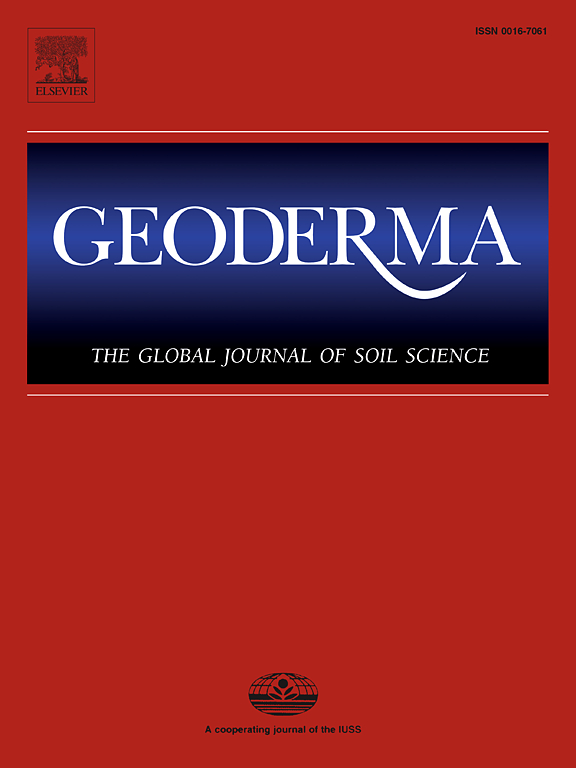Long-term management effects on depth gradients of 13C, 15N and C/N ratio in agricultural soils
IF 5.6
1区 农林科学
Q1 SOIL SCIENCE
引用次数: 0
Abstract
Agricultural management practices influence the turnover and residence time of soil organic matter (SOM) and thus can contribute to carbon (C) removal from the atmosphere. However, advanced analytical techniques are needed to disentangle the interlinked processes of SOM stabilisation and destabilisation, as well as its built-up and decomposition. Stable isotopes of C (δ13C) and nitrogen (N; δ15N) as well as the carbon-to-nitrogen (C/N) ratio provide information about the quality and thus origin and turnover SOM. The aim of this study was to quantify the effect of different agricultural management practices (mineral fertilisation, farmyard manure (FYM) application, straw incorporation, crop rotations, liming, irrigation and reduced tillage) on these indicators in topsoil and subsoil. Ten German long-term experiments (LTEs) were sampled down to 100 cm depth. Changes in SOC and N content were assessed as indicators of SOM quantity and changes in δ13C, δ15N and C/N ratios were assessed as indicators of SOM quality. Increases in C and N content were mainly affected in topsoil by mineral fertilisation, FYM, straw and irrigation. Changes in δ13C were limited to crop rotations (+0.62 ‰) and FYM (−0.27 ‰) in topsoil, but liming effects also reached down to 70 cm (−0.46 ‰ on average). Mineral fertilisation reduced the δ15N values in topsoil (−0.12 ‰), while the application of FYM increased them (+0.53 ‰), indicating different N sources. The δ15N values in the subsoil changed due to crop rotations (+0.62 ‰) and reduced tillage (−0.96 ‰). Specific management practices did not change C/N ratios significantly, with the exception of NPK fertilisation in topsoil (−1.32). Variations in SOC and total N content were more than 50 % greater in subsoil than in topsoil, but 13C and 15N did not follow this trend, indicating a decoupling of changes in C and N content and changes in SOM quality. This study revealed challenges in the detection of subsoil effects due to the low SOM content that in some LTEs unexplained large spatial variability in δ15N in subsoil. Since agricultural management practices change 13C, 15N and C/N ratios at least in topsoil, these variations need to be considered in isotope studies.
长期管理对农业土壤13C、15N深度梯度及碳氮比的影响
农业管理措施影响土壤有机质(SOM)的周转和停留时间,从而有助于从大气中去除碳(C)。然而,需要先进的分析技术来解开SOM稳定和不稳定的相互关联的过程,以及它的积累和分解。C (δ13C)和氮(N)的稳定同位素;δ15N)和碳氮比(C/N)提供了有机质质量的信息,从而提供了有机质的来源和周转的信息。本研究的目的是量化不同农业管理措施(矿物施肥、农家肥(FYM)施用、秸秆掺入、作物轮作、石灰化、灌溉和减少耕作)对表土和底土中这些指标的影响。10个德国长期实验(lte)取样至100 cm深度。土壤有机碳和氮含量的变化作为SOM数量的指标,δ13C、δ15N和C/N比值的变化作为SOM质量的指标。表土C、N含量的增加主要受矿肥、化肥、秸秆和灌溉的影响。表层土壤δ13C的变化仅限于作物轮作(+0.62‰)和FYM(- 0.27‰),但石灰化效应也达到70 cm(平均- 0.46‰)。矿肥降低了表层土壤的δ15N值(- 0.12‰),FYM增加了表层土壤的δ15N值(+0.53‰),表明不同的氮源。土壤δ15N值因轮作(+0.62‰)和减少耕作(- 0.96‰)而发生变化。除表层土壤氮磷钾施肥(- 1.32)外,具体管理措施对碳氮比没有显著影响。土壤有机碳和全氮含量的变化比表层土壤大50%以上,但13C和15N的变化不符合这一趋势,说明土壤有机质质量与碳、氮含量的变化不耦合。该研究揭示了由于低SOM含量在一些lte中无法解释地基中δ15N的大空间变异性,因此在检测地基效应方面存在挑战。由于农业管理措施至少在表层土壤中改变了13C、15N和C/N比率,因此在同位素研究中需要考虑这些变化。
本文章由计算机程序翻译,如有差异,请以英文原文为准。
求助全文
约1分钟内获得全文
求助全文
来源期刊

Geoderma
农林科学-土壤科学
CiteScore
11.80
自引率
6.60%
发文量
597
审稿时长
58 days
期刊介绍:
Geoderma - the global journal of soil science - welcomes authors, readers and soil research from all parts of the world, encourages worldwide soil studies, and embraces all aspects of soil science and its associated pedagogy. The journal particularly welcomes interdisciplinary work focusing on dynamic soil processes and functions across space and time.
 求助内容:
求助内容: 应助结果提醒方式:
应助结果提醒方式:


